介绍 Java开发中的23种设计模式中的结构型模式,共七种:适配器模式、装饰器模式、代理模式、外观模式、桥接模式、组合模式、享元模式。
1、适配器模式
适配器模式将某个类的接口转换成客户端期望的另一个接口表示,目的是消除由于接口不匹配所造成的类的兼容性问题。主要分为三类:类的适配器模式、对象的适配器模式、接口的适配器模式。首先,我们来看看类的适配器模式,先看类图:
//核心思想就是:有一个Source类,拥有一个方法,待适配,目标接口时Targetable,通过Adapter类,将Source的功能扩展到Targetable里,看代码:
public class Source {
public void method1() {
System.out.println("this is original method!");
}
}
public interface Targetable {
/* 与原类中的方法相同 */
public void method1();
/* 新类的方法 */
public void method2();
}
public class Adapter extends Source implements Targetable {
@Override
public void method2() {
System.out.println("this is the targetable method!");
}
}
//Adapter类继承Source类,实现Targetable接口,下面是测试类:
public class AdapterTest {
public static void main(String[] args) {
Targetable target = new Adapter();
target.method1();
target.method2();
}
}
//输出:
//this is original method!
//this is the targetable method!
//这样Targetable接口的实现类就具有了Source类的功能。对象的适配器模式
基本思路和类的适配器模式相同,只是将Adapter类作修改,这次不继承Source类,而是持有Source类的实例,以达到解决兼容性的问题。看图:

//只需要修改Adapter类的源码即可:
public class Wrapper implements Targetable {
private Source source;
public Wrapper(Source source){
super();
this.source = source;
}
@Override
public void method2() {
System.out.println("this is the targetable method!");
}
@Override
public void method1() {
source.method1();
}
}
//测试类:
public class AdapterTest {
public static void main(String[] args) {
Source source = new Source();
Targetable target = new Wrapper(source);
target.method1();
target.method2();
}
}
输出与第一种一样,只是适配的方法不同而已。
接口的适配器模式,
接口的适配器是这样的:有时我们写的一个接口中有多个抽象方法,当我们写该接口的实现类时,必须实现该接口的所有方法,这明显有时比较浪费,因为并不是所有的方法都是我们需要的,有时只需要某一些,此处为了解决这个问题,我们引入了接口的适配器模式,借助于一个抽象类,该抽象类实现了该接口,实现了所有的方法,而我们不和原始的接口打交道,只和该抽象类取得联系,所以我们写一个类,继承该抽象类,重写我们需要的方法就行。看一下类图:

这个很好理解,在实际开发中,我们也常会遇到这种接口中定义了太多的方法,以致于有时我们在一些实现类中并不是都需要。看代码:
[java] view plaincopy
public interface Sourceable {
public void method1();
public void method2();
}
抽象类Wrapper2:
[java] view plaincopy
public abstract class Wrapper2 implements Sourceable{
public void method1(){}
public void method2(){}
}
[java] view plaincopy
public class SourceSub1 extends Wrapper2 {
public void method1(){
System.out.println("the sourceable interface's first Sub1!");
}
}
[java] view plaincopy
public class SourceSub2 extends Wrapper2 {
public void method2(){
System.out.println("the sourceable interface's second Sub2!");
}
}
[java] view plaincopy
public class WrapperTest {
public static void main(String[] args) {
Sourceable source1 = new SourceSub1();
Sourceable source2 = new SourceSub2();
source1.method1();
source1.method2();
source2.method1();
source2.method2();
}
}
测试输出:
the sourceable interface's first Sub1!
the sourceable interface's second Sub2!达到了我们的效果!
讲了这么多,总结一下三种适配器模式的应用场景:
类的适配器模式:当希望将一个类转换成满足另一个新接口的类时,可以使用类的适配器模式,创建一个新类,继承原有的类,实现新的接口即可。
对象的适配器模式:当希望将一个对象转换成满足另一个新接口的对象时,可以创建一个Wrapper类,持有原类的一个实例,在Wrapper类的方法中,调用实例的方法就行。
接口的适配器模式:当不希望实现一个接口中所有的方法时,可以创建一个抽象类Wrapper,实现所有方法,我们写别的类的时候,继承抽象类即可。
7、装饰模式(Decorator)
顾名思义,装饰模式就是给一个对象增加一些新的功能,而且是动态的,要求装饰对象和被装饰对象实现同一个接口,装饰对象持有被装饰对象的实例,关系图如下:
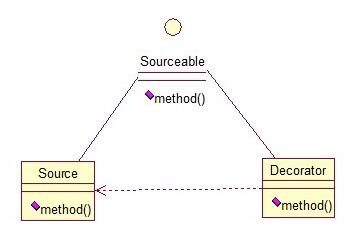
//Source类是被装饰类,Decorator类是一个装饰类,可以为Source类动态的添加一些功能,代码如下:
public interface Sourceable {
public void method();
}
public class Source implements Sourceable {
@Override
public void method() {
System.out.println("the original method!");
}
}
public class Decorator implements Sourceable {
private Sourceable source;
public Decorator(Sourceable source){
super();
this.source = source;
}
@Override
public void method() {
System.out.println("before decorator!");
source.method();
System.out.println("after decorator!");
}
}
//测试类:
public class DecoratorTest {
public static void main(String[] args) {
Sourceable source = new Source();
Sourceable obj = new Decorator(source);
obj.method();
}
}
//输出:
//before decorator!
//the original method!
//after decorator!装饰器模式的应用场景:
1、需要扩展一个类的功能。
2、动态的为一个对象增加功能,而且还能动态撤销。(继承不能做到这一点,继承的功能是静态的,不能动态增删。)
缺点:产生过多相似的对象,不易排错!
8、代理模式(Proxy)
其实每个模式名称就表明了该模式的作用,代理模式就是多一个代理类出来,替原对象进行一些操作,比如我们在租房子的时候回去找中介,为什么呢?因为你对该地区房屋的信息掌握的不够全面,希望找一个更熟悉的人去帮你做,此处的代理就是这个意思。再如我们有的时候打官司,我们需要请律师,因为律师在法律方面有专长,可以替我们进行操作,表达我们的想法。先来看看关系图:
//根据上文的阐述,代理模式就比较容易的理解了,我们看下代码:
public interface Sourceable {
public void method();
}
public class Source implements Sourceable {
@Override
public void method() {
System.out.println("the original method!");
}
}
public class Proxy implements Sourceable {
private Source source;
public Proxy(){
super();
this.source = new Source();
}
@Override
public void method() {
before();
source.method();
atfer();
}
private void atfer() {
System.out.println("after proxy!");
}
private void before() {
System.out.println("before proxy!");
}
}
//测试类:
public class ProxyTest {
public static void main(String[] args) {
Sourceable source = new Proxy();
source.method();
}
}
//输出:
//before proxy!
//the original method!
//after proxy!代理模式的应用场景:
如果已有的方法在使用的时候需要对原有的方法进行改进,此时有两种办法:
1、修改原有的方法来适应。这样违反了“对扩展开放,对修改关闭”的原则。
2、就是采用一个代理类调用原有的方法,且对产生的结果进行控制。这种方法就是代理模式。
使用代理模式,可以将功能划分的更加清晰,有助于后期维护!
9、外观模式(Facade)
外观模式是为了解决类与类之家的依赖关系的,像spring一样,可以将类和类之间的关系配置到配置文件中,而外观模式就是将他们的关系放在一个Facade类中,降低了类类之间的耦合度,该模式中没有涉及到接口,看下类图:(我们以一个计算机的启动过程为例)
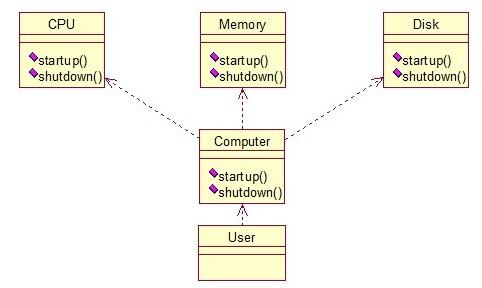
//我们先看下实现类:
public class CPU {
public void startup(){
System.out.println("cpu startup!");
}
public void shutdown(){
System.out.println("cpu shutdown!");
}
}
public class Memory {
public void startup(){
System.out.println("memory startup!");
}
public void shutdown(){
System.out.println("memory shutdown!");
}
}
public class Disk {
public void startup(){
System.out.println("disk startup!");
}
public void shutdown(){
System.out.println("disk shutdown!");
}
}
public class Computer {
private CPU cpu;
private Memory memory;
private Disk disk;
public Computer(){
cpu = new CPU();
memory = new Memory();
disk = new Disk();
}
public void startup(){
System.out.println("start the computer!");
cpu.startup();
memory.startup();
disk.startup();
System.out.println("start computer finished!");
}
public void shutdown(){
System.out.println("begin to close the computer!");
cpu.shutdown();
memory.shutdown();
disk.shutdown();
System.out.println("computer closed!");
}
}
//User类如下:
public class User {
public static void main(String[] args) {
Computer computer = new Computer();
computer.startup();
computer.shutdown();
}
}
//输出:
//start the computer!
//cpu startup!
//memory startup!
//disk startup!
//start computer finished!
//begin to close the computer!
//cpu shutdown!
//memory shutdown!
//disk shutdown!
//computer closed!如果我们没有Computer类,那么,CPU、Memory、Disk他们之间将会相互持有实例,产生关系,这样会造成严重的依赖,修改一个类,可能会带来其他类的修改,这不是我们想要看到的,有了Computer类,他们之间的关系被放在了Computer类里,这样就起到了解耦的作用,这,就是外观模式!
10、桥接模式(Bridge)
桥接模式就是把事物和其具体实现分开,使他们可以各自独立的变化。桥接的用意是:将抽象化与实现化解耦,使得二者可以独立变化,像我们常用的JDBC桥DriverManager一样,JDBC进行连接数据库的时候,在各个数据库之间进行切换,基本不需要动太多的代码,甚至丝毫不用动,原因就是JDBC提供统一接口,每个数据库提供各自的实现,用一个叫做数据库驱动的程序来桥接就行了。我们来看看关系图:
//实现代码:
//先定义接口:
public interface Sourceable {
public void method();
}
//分别定义两个实现类:
public class SourceSub1 implements Sourceable {
@Override
public void method() {
System.out.println("this is the first sub!");
}
}
public class SourceSub2 implements Sourceable {
@Override
public void method() {
System.out.println("this is the second sub!");
}
}
//定义一个桥,持有Sourceable的一个实例:
public abstract class Bridge {
private Sourceable source;
public void method(){
source.method();
}
public Sourceable getSource() {
return source;
}
public void setSource(Sourceable source) {
this.source = source;
}
}
public class MyBridge extends Bridge {
public void method(){
getSource().method();
}
}
//测试类:
public class BridgeTest {
public static void main(String[] args) {
Bridge bridge = new MyBridge();
/*调用第一个对象*/
Sourceable source1 = new SourceSub1();
bridge.setSource(source1);
bridge.method();
/*调用第二个对象*/
Sourceable source2 = new SourceSub2();
bridge.setSource(source2);
bridge.method();
}
}
//output:
//this is the first sub!
//this is the second sub!
11、组合模式(Composite)
组合模式有时又叫部分-整体模式在处理类似树形结构的问题时比较方便,看看关系图:
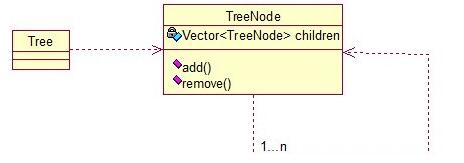
//直接来看代码:
public class TreeNode {
private String name;
private TreeNode parent;
private Vector<TreeNode> children = new Vector<TreeNode>();
public TreeNode(String name){
this.name = name;
}
public String getName() {
return name;
}
public void setName(String name) {
this.name = name;
}
public TreeNode getParent() {
return parent;
}
public void setParent(TreeNode parent) {
this.parent = parent;
}
//添加孩子节点
public void add(TreeNode node){
children.add(node);
}
//删除孩子节点
public void remove(TreeNode node){
children.remove(node);
}
//取得孩子节点
public Enumeration<TreeNode> getChildren(){
return children.elements();
}
}
public class Tree {
TreeNode root = null;
public Tree(String name) {
root = new TreeNode(name);
}
public static void main(String[] args) {
Tree tree = new Tree("A");
TreeNode nodeB = new TreeNode("B");
TreeNode nodeC = new TreeNode("C");
nodeB.add(nodeC);
tree.root.add(nodeB);
System.out.println("build the tree finished!");
}
}
使用场景:将多个对象组合在一起进行操作,常用于表示树形结构中,例如二叉树,数等。
12、享元模式(Flyweight)
享元模式的主要目的是实现对象的共享,即共享池,当系统中对象多的时候可以减少内存的开销,通常与工厂模式一起使用。
FlyWeightFactory负责创建和管理享元单元,当一个客户端请求时,工厂需要检查当前对象池中是否有符合条件的对象,如果有,就返回已经存在的对象,如果没有,则创建一个新对象,FlyWeight是超类。一提到共享池,我们很容易联想到Java里面的JDBC连接池,想想每个连接的特点,我们不难总结出:适用于作共享的一些个对象,他们有一些共有的属性,就拿数据库连接池来说,url、driverClassName、username、password及dbname,这些属性对于每个连接来说都是一样的,所以就适合用享元模式来处理,建一个工厂类,将上述类似属性作为内部数据,其它的作为外部数据,在方法调用时,当做参数传进来,这样就节省了空间,减少了实例的数量。
看个例子:
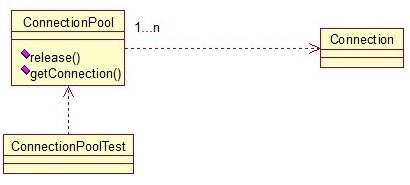
//看下数据库连接池的代码:
public class ConnectionPool {
private Vector<Connection> pool;
/*公有属性*/
private String url = "jdbc:mysql://localhost:3306/test";
private String username = "root";
private String password = "root";
private String driverClassName = "com.mysql.jdbc.Driver";
private int poolSize = 100;
private static ConnectionPool instance = null;
Connection conn = null;
/*构造方法,做一些初始化工作*/
private ConnectionPool() {
pool = new Vector<Connection>(poolSize);
for (int i = 0; i < poolSize; i++) {
try {
Class.forName(driverClassName);
conn = DriverManager.getConnection(url, username, password);
pool.add(conn);
} catch (ClassNotFoundException e) {
e.printStackTrace();
} catch (SQLException e) {
e.printStackTrace();
}
}
}
/* 返回连接到连接池 */
public synchronized void release() {
pool.add(conn);
}
/* 返回连接池中的一个数据库连接 */
public synchronized Connection getConnection() {
if (pool.size() > 0) {
Connection conn = pool.get(0);
pool.remove(conn);
return conn;
} else {
return null;
}
}
}










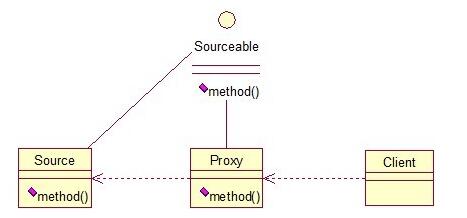
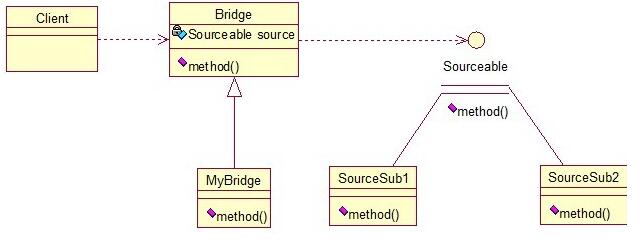

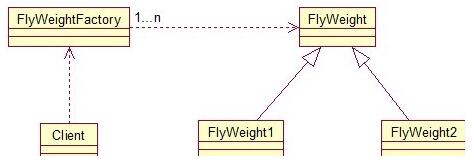














 49万+
49万+

 被折叠的 条评论
为什么被折叠?
被折叠的 条评论
为什么被折叠?








